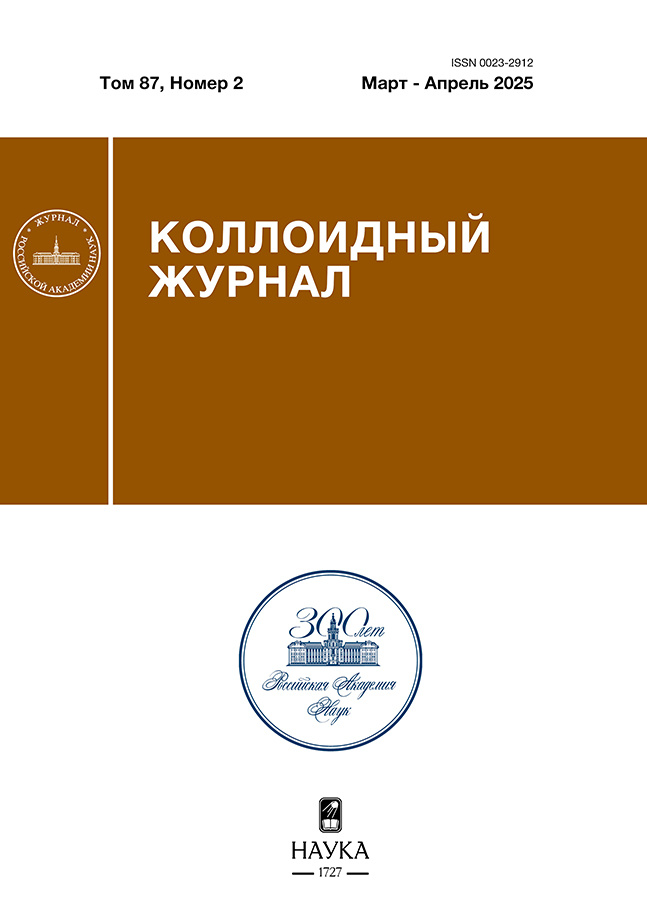On the electrostatic interaction of dielectric particles in an electrolyte solution in the strong screening regime
- Авторлар: Grashchenkov S.I.1
-
Мекемелер:
- Псковский государственный университет
- Шығарылым: Том 87, № 2 (2025)
- Беттер: 101-108
- Бөлім: Articles
- ##submission.dateSubmitted##: 06.07.2025
- ##submission.dateAccepted##: 06.07.2025
- ##submission.datePublished##: 06.07.2025
- URL: https://ta-journal.ru/0023-2912/article/view/686794
- DOI: https://doi.org/10.31857/S0023291225020023
- EDN: https://elibrary.ru/tphhnt
- ID: 686794
Дәйексөз келтіру
Аннотация
The electrostatic interaction between two identical charged dielectric spherical particles in a symmetric electrolyte solution is studied based on the Poisson-Boltzmann equation. Particular attention is paid to the case of high surface potentials of particles, whose radii are significantly larger than the Debye radius. Using the finite element method, the interaction forces between the particles are calculated under the assumption of a uniform charge distribution on their surfaces and in the absence of an external electric field. This study demonstrates that accounting for the nonlinearity of the Poisson-Boltzmann equation may be essential, even when the surface potentials of particles are sufficiently small, allowing for the formal application of the linearized Poisson-Boltzmann equation. The results obtained can be useful for understanding processes in colloidal systems and analyzing experiments on the interaction of micron-sized particles in electrolyte solutions.
Толық мәтін
Авторлар туралы
S. Grashchenkov
Псковский государственный университет
Хат алмасуға жауапты Автор.
Email: grasi@mail.ru
Ресей, Псков
Әдебиет тізімі
- Israelachvili J.N. Intermolecular and surface forces. San Diego: Academic press, 2011.
- Ledbetter J.E., Croxton T.L., McQuarrie D.A. The interaction of two charged spheres in the Poisson-Boltzmann equation // Can. J. Chem. 1981. V. 59. № 13. P. 1860–1864. https://doi.org/10.1139/v81-277
- Gouy M. Sur la constitution de la charge électrique à la surface d’un électrolyte // J. Phys. Theor. Appl. 1910. V. 9. № 1. P. 457–468. https://doi.org/10.1051/jphystap:019100090045700
- Huckel E., Debye P. Zur theorie der elektrolyte. I. Gefrierpunktserniedrigung und verwandte erscheinungen // Phys. Z. 1923. V. 24. P. 185–206.
- Lamm G. The Poisson-Boltzmann equation // Reviews in computational chemistry. 2003. V. 19. P. 147–365. https://doi.org/10.1002/0471466638.ch4
- Budkov Y.A., Kalikin N.N. Statistical field theory of ion-molecular fluids: fundamentals and applications in physical chemistry and electrochemistry. Springer Nature, 2024.
- Derjaguin B., Landau L. Theory of the stability of strongly charged lyophobic sols and of the adhesion of strongly charged particles in solutions of electrolytes // Prog. Surf. Sci. 1993.V. 43. № 1–4. P. 30−59. https://doi.org/10.1016/0079-6816(93)90013-L
- Ether D.S. et al. Double-layer force suppression between charged microspheres // Phys. Rev. E. 2018. V. 97. № 2. P. 022611. https://doi.org/10.1103/PhysRevE.97.022611
- Derjaguin B. On the repulsive forces between charged colloid particles and on the theory of slow coagulation and stability of lyophobe sols // Prog. Surf. Sci. 1993. V. 43. № 1–4. P. 15–27. https://doi.org/10.1016/0079-6816(93)90011-J
- Carnie S.L., Chan D.Y.C., Stankovich J. Computation of forces between spherical colloidal particles: nonlinear Poisson-Boltzmann theory // J. Colloid Int. Sci. 1994. V. 165. № 1. P. 116–128. https://doi.org/10.1006/jcis.1994.1212
- Lima E.R.A., Tavares F.W., Biscaia Jr E.C. Finite volume solution of the modified Poisson-Boltzmann equation for two colloidal particles // Phys. Chem. Chem. Phys. 2007. V. 9. № 24. P. 3174–3180. https://doi.org/10.1039/b701170a
- Russ C. et al. Three-body forces between charged colloidal particles // Phys. Rev. E. 2002. V. 66. № 1. P. 011402 https://doi.org/10.1103/PhysRevE.66.011402
- Warszyński P., Adamczyk Z. Calculations of double-layer electrostatic interactions for the sphere/plane geometry // J. Colloid Int. Sci. 1997. V. 187. № 2. P. 283–295. https://doi.org/10.1006/jcis.1996.4671
- Гращенков С.И. Электростатическое взаимодействие диэлектрических частиц в растворе электролита // Коллоидный журнал. 2024. Т. 86. № 5. С. 561–570. https://doi.org/10.31857/S0023291224050045
- Schnitzer O., Morozov M. A generalized Derjaguin approximation for electrical-double-layer interactions at arbitrary separations // J. Chem. Phys. 2015. V. 142. № 24. P. 244102. https://doi.org/10.1063/1.4922546
- Фортов В.Е. , Храпак А.Г., Храпак С.А., Молотков В.И., Петров О.Ф. Пылевая плазма // УФН. 2004. Т. 174. № 5. С. 495–544. https://doi.org/10.3367/UFNr.0174.200405b.0495
- Griffiths M.R. et al. Measuring the interaction between a pair of emulsion droplets using dual-trap optical tweezers // RSC advances. 2016. V. 6. № 18. P. 14538–14546. https://doi.org/10.1039/C5RA25073K
- Chen A. et al. In situ measurements of interactions between switchable surface-active colloid particles using optical tweezers // Langmuir. 2020. V. 36. №. 17. P. 4664–4670. https://doi.org/10.1021/acs.langmuir.0c00398
- Liu S. et al. In situ measurement of depletion caused by SDBS micelles on the surface of silica particles using optical tweezers // Langmuir. 2019. V. 35. № 42. P. 13536–13542. https://doi.org/10.1021/acs.langmuir.9b02041
- Vugrin K.W. et al. Confidence region estimation techniques for nonlinear regression in groundwater flow: Three case studies // Water Resources Research. 2007. V. 43. № 3. P. W03423. https://doi.org/10.1029/2005WR004804
Қосымша файлдар













